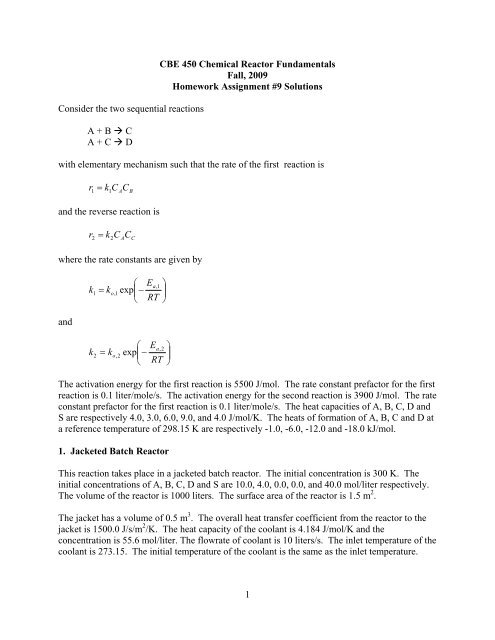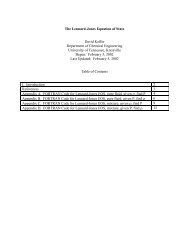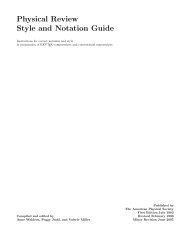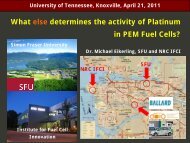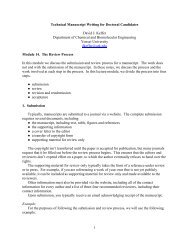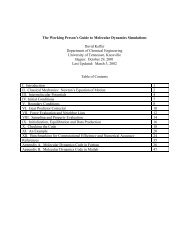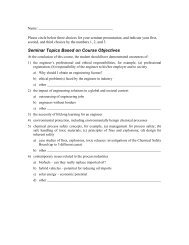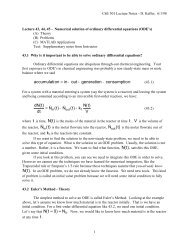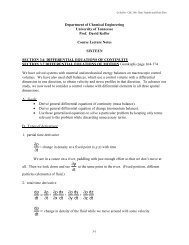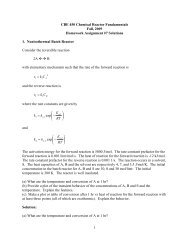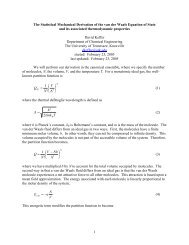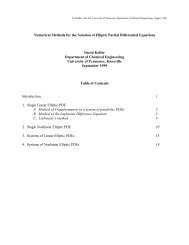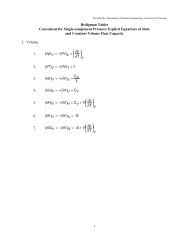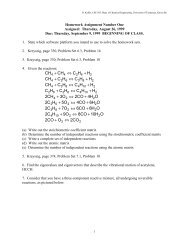Homework 9 Solutions
Homework 9 Solutions
Homework 9 Solutions
You also want an ePaper? Increase the reach of your titles
YUMPU automatically turns print PDFs into web optimized ePapers that Google loves.
The final concentration of A is 2.0 mol/liter.The final concentration of B is 0.0 mol/liter.The final concentration of C is 0.0 mol/liter.The final concentration of D is 4.0 mol/liter.The final temperature of the reactor is 274.7 K.The final temperature of the jacket is 274.0 K.The final conversion isXAC1CAA,in1210 0.82. Jacketed CSTRThis reaction takes place in a jacketed CSTR. The inlet concentration is 300 K. The inletconcentrations of A, B, C, D and S are 10.0, 4.0, 0.0, 0.0, and 40.0 mol/liter respectively. Theinitial conditions within the CSTR are the same as the inlet conditions. The inlet flowrate is 1liter/s. The volume of the reactor is 1000 liters. The surface area of the reactor is 1.5 m 2 .The jacket has a volume of 0.5 m 3 . The overall heat transfer coefficient from the reactor to thejacket is 1500.0 J/s/m 2 /K. The heat capacity of the coolant is 4.184 J/mol/K and theconcentration is 55.6 mol/liter. The flowrate of coolant is 10 liters/s. The inlet temperature of thecoolant is 273.15. The initial temperature of the coolant is the same as the inlet temperature.(a) Provide a plot of the transient behavior of the concentrations of A, B, C, D and S and thetemperatures for a period of X sec. Explain the features.(b) What are the reactor and jacket temperatures, conversion of A and concentrations of C and Dat steady state?Solution:I used the following input file:function dydt = sysodeinput(x,y,nvec);%% two sequential reactions in solvent, S% A + B --> C% A + C --> D%% example usage:% [y,x]=sysode(2,1000,0,1000,[10,4,0,0,40,300,273.15]);%CA = y(1); % mol/literCB = y(2); % mol/literCC = y(3); % mol/literCD = y(4); % mol/literCS = y(5); % mol/literT = y(6); % KTj = y(7); % K%% stoichiometry%5
CCin = 0.0; % mol/literCDin = 0.0; % mol/literCSin = 40.0; % mol/literTin = 300.0; % K%% mole fractions%CT = CA + CB + CC + CD + CS;xA = CA/CT;xB = CB/CT;xC = CC/CT;xD = CD/CT;xS = CS/CT;CTin = CAin + CBin + CCin + CDin + CSin;xAin = CAin/CTin;xBin = CBin/CTin;xCin = CCin/CTin;xDin = CDin/CTin;xSin = CSin/CTin;%% mixture heat capacity%Cpmix = xA*CpA + xB*CpB + xC*CpC + xD*CpD + xS*CpS;Cpmixin = xAin*CpA + xBin*CpB + xCin*CpC + xDin*CpD + xSin*CpS;%% heat loss information%As = 1.5; % m^2U = 1500.0; % J/s/m^2/KQdot = As*U*(Tj-T);Vj = 500; % litersCpj = 4.184; % J/mol/KCj = 55.6; % mol/literFj = 10.0; % liters/secTjin = 273.15; % K%% molar balances%dydt(1) = Fin/V*CAin - Fout/V*CA + nuA1*r1 + nuA2*r2;dydt(2) = Fin/V*CBin - Fout/V*CB + nuB1*r1 + nuB2*r2;dydt(3) = Fin/V*CCin - Fout/V*CC + nuC1*r1 + nuC2*r2;dydt(4) = Fin/V*CDin - Fout/V*CD + nuD1*r1 + nuD2*r2;dydt(5) = Fin/V*CSin - Fout/V*CS + nuS1*r1 + nuS2*r2;dydt(6) = ( Fin/V*CTin*Cpmixin*(Tin - T) - DHR1*r1 - DHR2*r2 + Qdot/V )/(CT*Cpmix);dydt(7) = Fj/Vj*(Tjin-Tj) - Qdot/(Cj*Cpj*Vj);I used the following command[y,x]=sysode(2,1000,0,1000,[10,4,0,0,40,300,273.15]);I generated the plot of the transient behavior (the solution for part A).7
43.532.51234567y21.510.500 100 200 300 400 500 600 700 800 900 1000xwhere the legend corresponds to A, B, C, D S, T and Tj. The concentrations are normalized bythe inlet concentration of A. The temperatures are normalized by their inlet temperatures.In this plot, A decreases as a reactant. B is consumed as a reactant. C initially increases as aproduct of reaction 1 and then decreases as it is consumed in reaction 2. D increases as product.The solvent doesn’t participate in the reaction and is constant. T increases since both reactionsare exothermic. The jacket temperature also increases as it removes heat from the system. Itappears in this normalized plot that the temperature of the jacket becomes greater than thetemperature of the reactor. This is not true and is only a consequence of normalizing the twotemperatures by their (different) inlet values.The final line of the unnormalized output file is1.0000000e+003 2.3582167e+000 1.4199325e-001 7.4230191e-002 3.7837766e+000 4.0000000e+001 3.0602761e+002 2.8935481e+002The final concentration of A is 2.36 mol/liter.The final concentration of B is 0.14 mol/liter.The final concentration of C is 0.07 mol/liter.The final concentration of D is 3.78 mol/liter.The final temperature of the reactor is 306.0 K.The final temperature of the jacket is 289.3 K.The steady state conversion is8
XAC1CAA,in2.361 0.764103. Jacketed PFRThis reaction takes place in a jacketed CSTR. The inlet concentration is 300 K. The inletconcentrations of A, B, C, D and S are 10.0, 4.0, 0.0, 0.0, and 30.0 mol/liter respectively. Theinitial conditions within the CSTR are the same as the inlet conditions. The inlet flowrate is 1liter/s. The volume of the reactor is 1000 liters. The reactor is circular with diameter 0.1 m.The jacket is a cylindrical shell of diameter 0.2 m around the reactor. It is of the same length asthe reactor. The overall heat transfer coefficient from the reactor to the jacket is 1500.0J/s/m 2 /K. The heat capacity of the coolant is 4.184 J/mol/K and the concentration is 55.6mol/liter. The flowrate of coolant is 10 liters/s and is co-current. The inlet temperature of thecoolant is 273.15. The initial temperature of the coolant is the same as the inlet temperature.(a) Provide a plot of the steady state profiles of the concentrations of A, B, C, D and S and thetemperatures. Explain the features.(b) What are the reactor and jacket temperatures, conversion of A and concentrations of C and Dat the exit of the reactor?Solution:I used the following input file:function dydt = sysodeinput(x,y,nvec);%% two sequential reactions in solvent, S% A + B --> C% A + C --> D%% example usage:% [y,x] = sysode(2,1000,0,127.324,[10000,4000,0,0,40000,300,273.15]);%CA = y(1); % mol/m^3CB = y(2); % mol/m^3CC = y(3); % mol/m^3CD = y(4); % mol/m^3CS = y(5); % mol/m^3T = y(6); % KTj = y(7); % K%% stoichiometry%nuA1 = -1;nuB1 = -1;nuC1 = 1;nuD1 = 0;nuS1 = 0;%nuA2 = -1;nuB2 = 0;9
nuC2 = -1;nuD2 = 1;nuS2 = 0;%% rate law for reaction 1%R = 8.314; % J/mol/Kko1 = 0.1; % liter/mol/secko1 = ko1/1000; % m^3/mol/secEa1 = 5500; % J/molk1 = ko1*exp(-Ea1/(R*T));r1 = k1*CA*CB;%% pure component heat capacities%CpA = 4.0; %J/mol/KCpB = 3.0; %J/mol/KCpC = 6.0; %J/mol/KCpD = 9.0; %J/mol/KCpS = 4.0; %J/mol/K%% enthalpies of formation%Tref = 298.15; % Kpref = 101325; % PaHfrefA = -1000; %J/molHfrefB = -6000; % J/molHfrefC = -12000; % J/molHfrefD = -18000; % J/molHA = CpA*(T-Tref) + HfrefA;HB = CpB*(T-Tref) + HfrefB;HC = CpC*(T-Tref) + HfrefC;HD = CpD*(T-Tref) + HfrefD;DHR1 = nuA1*HA + nuB1*HB + nuC1*HC + nuD1*HD;DHR2 = nuA2*HA + nuB2*HB + nuC2*HC + nuD2*HD;%% rate law for reaction 2%ko2 = 0.1; % liter/mol/secko2 = ko2/1000; % m^3/mol/secEa2 = 3900; % J/molk2 = ko2*exp(-Ea2/(R*T));r2 = k2*CA*CC;%% inlet concentrations and temperature%CAin = 10000.0; % mol/m^3CBin = 4000.0; % mol/m^3CCin = 0.0; % mol/m^3CDin = 0000.0; % mol/m^3CSin = 40000.0; % mol/m^3Tin = 300.0; % K%% mole fractions%CT = CA + CB + CC + CD + CS;xA = CA/CT;xB = CB/CT;xC = CC/CT;xD = CD/CT;xS = CS/CT;CTin = CAin + CBin + CCin + CDin + CSin;10
xAin = CAin/CTin;xBin = CBin/CTin;xCin = CCin/CTin;xDin = CDin/CTin;xSin = CSin/CTin;%% mixture heat capacity%Cpmix = xA*CpA + xB*CpB + xC*CpC + xD*CpD + xS*CpS;Cpmixin = xAin*CpA + xBin*CpB + xCin*CpC + xDin*CpD + xSin*CpS;%% volumetric flowrate%F = 1; % liter/secF = F/1000; % cubic meters/sec%% circular pipe%V = 1.0; % m^3Dp = 0.10; % mAcross = 0.25*pi*Dp*Dp; % m^2l = V/Across; % mV = Across*l; % m^3%% axial velocity%vz = F/Across; % m/s%% residence time%tr = l/vz; % sec%% heat loss information%As = 1.5; % m^2U = 1500.0; % J/s/m^2/KQdot = As*U*(Tj-T);Cpj = 4.184; % J/mol/KCj = 55.6; % mol/literCj = Cj*1000; % mol/cubic meterFj = 10.0; % liters/secFj = Fj/1000; % cubic meters/secTjin = 273.15; % KDpj = 0.20; % mAcrossj = 0.25*pi*Dpj*Dpj; % m^2Vj = Acrossj*l; % m^3vzj = Fj/Acrossj; % m/s%% molar balances%% dCAdz = nuA*r/vdydt(1) = (nuA1*r1 + nuA2*r2)/vz;dydt(2) = (nuB1*r1 + nuB2*r2)/vz;dydt(3) = (nuC1*r1 + nuC2*r2)/vz;dydt(4) = (nuD1*r1 + nuD2*r2)/vz;dydt(5) = (nuS1*r1 + nuS2*r2)/vz;dydt(6) = (-DHR1*r1 - DHR2*r2 + Qdot/V)/(vz*CT*Cpmix);dydt(7) = -Qdot/(vzj*Vj*Cj*Cpj);I used the following command11
[y,x] = sysode(2,1000,0,127.324,[10000,4000,0,0,40000,300,273.15]);I generated the plot of the transient behavior (the solution for part A).43.532.51234567y21.510.500 20 40 60 80 100 120 140xwhere the legend corresponds to A, B, C, D S, T and Tj. The concentrations are normalized bythe inlet concentration of A. The temperatures are normalized by their inlet temperatures.In this plot, A decreases as a reactant. B is consumed as a reactant. C initially increases as aproduct of reaction 1 and then decreases as it is consumed in reaction 2. D increases as product.The solvent doesn’t participate in the reaction and is constant. T increases since both reactionsare exothermic. The jacket temperature also increases as it removes heat from the system. Itappears in this normalized plot that the temperature of the jacket becomes greater than thetemperature of the reactor. This is not true and is only a consequence of normalizing the twotemperatures by their (different) inlet values.The final line of the unnormalized output file is1.2732400e+002 2.0000000e+003 4.0767164e-008 4.3518457e-008 4.0000000e+003 4.0000000e+004 2.9113046e+002 2.9112881e+002The final concentration of A is 2.00 mol/liter.The final concentration of B is 0.00 mol/liter.The final concentration of C is 0.00 mol/liter.The final concentration of D is 4.0 mol/liter.12
The final temperature of the reactor is 291.1130 K.The final temperature of the jacket is 291.1128 K.The final conversion isXAC 1CAA,in 12.10 0.813


